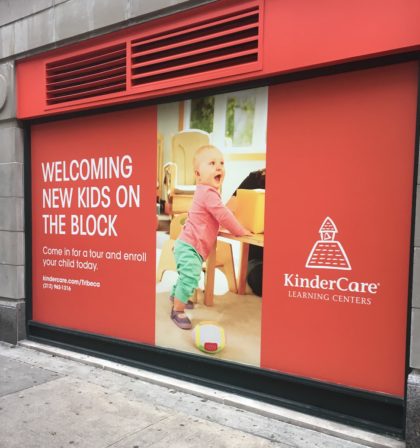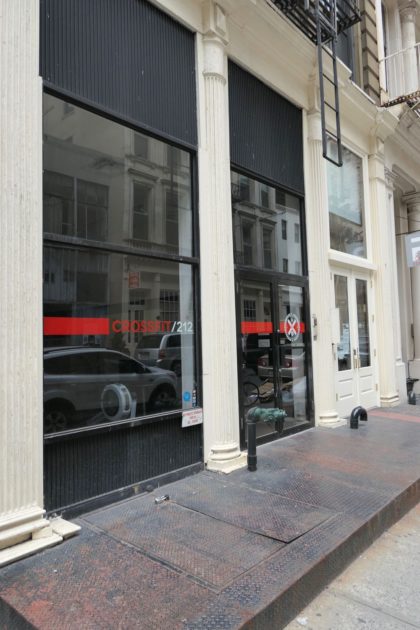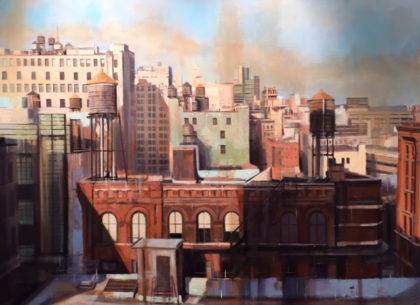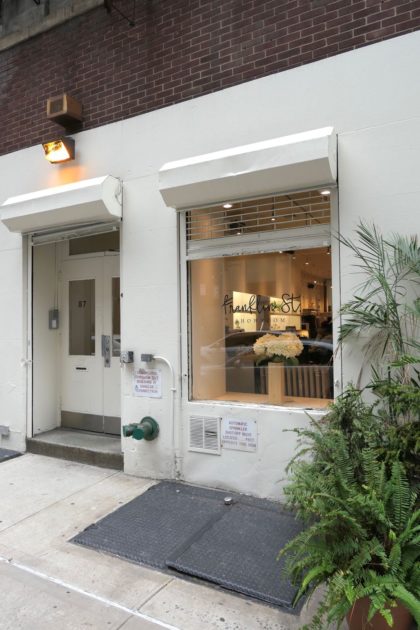Seen & Heard: CrossFit Studio Is Said to Be Closing
••• “I think turning one’s windows into billboards is despicable,” says S. (The second photo is by B.) You know I’m no fan, but I assume this is temporary (only till KinderCare opens). What really bums me out is when a business rents out its windows to outside advertisers.

 ••• H. says that CrossFit 212 is closing its studio at 84 Franklin, but I haven’t been able to confirm that with the company (which also has studios on Broadway—in Tribeca and Noho—and in FiDi).
••• H. says that CrossFit 212 is closing its studio at 84 Franklin, but I haven’t been able to confirm that with the company (which also has studios on Broadway—in Tribeca and Noho—and in FiDi).
 ••• Opening Nov. 2 at Steven Amedee: “New Paintings” by Jeff Bye. This one is of Soho.
••• Opening Nov. 2 at Steven Amedee: “New Paintings” by Jeff Bye. This one is of Soho.
 ••• The other night, some friends who live in a fancy new West Village building said that the developer created a certain number of studio apartments meant for owners’ staff (or, conceivably, a relative)—and they can only be sold to people who own in the building, akin to a storage unit, parking space, or cabana. This was the first I had heard of such a thing, but I suspect it won’t be long before the New York Times Real Estate section drums up 2,000 words on the topic.
••• The other night, some friends who live in a fancy new West Village building said that the developer created a certain number of studio apartments meant for owners’ staff (or, conceivably, a relative)—and they can only be sold to people who own in the building, akin to a storage unit, parking space, or cabana. This was the first I had heard of such a thing, but I suspect it won’t be long before the New York Times Real Estate section drums up 2,000 words on the topic.
••• I had subconsciously noticed that the Steven Alan showroom at 87 Franklin had rebranded as Franklin St. Showroom, but I didn’t realize that Steven Alan spun it off. An explanation from Modem:
With the opening of his first store in 1994, Steven Alan quickly became known not only for the emergence of the casual cool world of shirting, but also his special finds and curated pieces from up and coming designers. Recognizing the need to assist those emerging designers in navigating the build out of their wholesale business, while continuing to nurture and preserve the brand itself,the Steven Alan Showroom was launched in 1997. The Showroom was renamed to the Franklin St. Showroom in early 2017 to mark a new beginning.As the Showroom brands eclipsed in size that of Steven Alan, the namesake brand was taken back in house leaving a growing showroom and its team to move its reputation under a new umbrella.












“Of course, the concept is hardly a new one. In Manhattan’s Gilded Age, buildings often incorporated smaller accessory apartments (mostly studios for staff) tucked just below the roof. It’s the reason there are so many pronounced cornices among developments from that era. While many of these vintage examples have been swallowed up by surrounding apartments, the strategy is now being revived in luxury conversions and new builds.”
http://nypost.com/2016/06/17/rich-people-are-buying-secret-luxury-apartments-for-the-help/
From The New York Times, April 2012
“Lofty Perches Whose Only Luxury Was the View”
” […] Until penthouse living became popular in the 1920s, extra staff rooms were often found at a building’s highest reaches. Explanations from historians include a reluctance to put wealthy buyers next to rooftop laundry facilities and a distaste for views of puffing chimneys and water towers.
“But many of those staff rooms had views of other things, too. Like Central Park. At the Dakota, on 72nd Street and Central Park West, for example, the windows are much smaller on the top two floors, which were built for the staff. But even through those relatively small windows, the long and wide views of Central Park can take the air out of your lungs.
“Of the several dozen staff rooms originally built at the Dakota, only a fraction remain. The rest have been combined to make larger apartments, as has happened with most servants’ quarters around the city. These composite apartments can have great views, but the spaces tend to lack the flourish and grandeur of apartments on lower floors, because the raw ingredients were so very bare.
“Staff rooms were built only a few feet across, with just enough space for a single bed against the wall and a tiny sink in the corner. They had no kitchens — their occupants would presumably have eaten in the boss’s apartment with the other staff members, said Andrew S. Dolkart, the director of Columbia University’s historic preservation program. The bathrooms, often shared by occupants of a dozen rooms, were down the hall. In most cases, they were accessible only by riding the freight elevator or hoofing it up the stairs.
“Today, the few new buildings that offer staff accommodations go about it a little differently. At 15 Central Park West, which opened in 2008, there are two dozen “staff suites,” as they are called in broker parlance. They are on low floors at the back of the building, and though they do not have park views, they lack for little else.
“‘Anywhere else, they would be luxury studios,’ Mr. Burger said.
“Brokers estimate that less than 10 percent of the separate servants’ quarters that remain in old buildings are still used as housing — perhaps a nanny here, a child home from college there. Instead, they can be offices, guest rooms or private gyms. Most often, however, they are elaborate storage closets, where junky old skis and off-season sweaters are bathed in sunlight. […]”
https://www.nytimes.com/2012/04/03/nyregion/an-apartment-high-above-5th-avenue-but-without-frills.html
Hi there!
I appreciate your concerns about turning windows into billboards, it is so sad to see architecture diminished by pragmatic rather than poetic design decisions. It’s happening far too often these days.
I am the Architectural Drafter here at KinderCare and as the person who mocked-up these window clings, I have an interesting perspective I think you might appreciate. Really just food for thought:
The reason why these window clings look like billboards is not a marketing decision but one of visibility and the right to privacy of the children from the public. We had to cover the windows up to the top because of line-of-sight concerns from people in neighboring buildings.
We respect the rights of the children enrolled at KinderCare and offer a privacy agreement upon enrollment which many parents have expressed as a reassurance. At every level of KC, our permanently central concern is the safety and well-being of Children.
We can’t control the public realm, but we can at least help prevent negative incidences by controlling our environment.
This makes me wonder if banks and other institutions are considering privacy as well or even being regulated by code to prevent access to sensitive information… its not my jurisdiction but I wouldn’t be surprised.
Now, for that giant LED screen in the bank window… ???